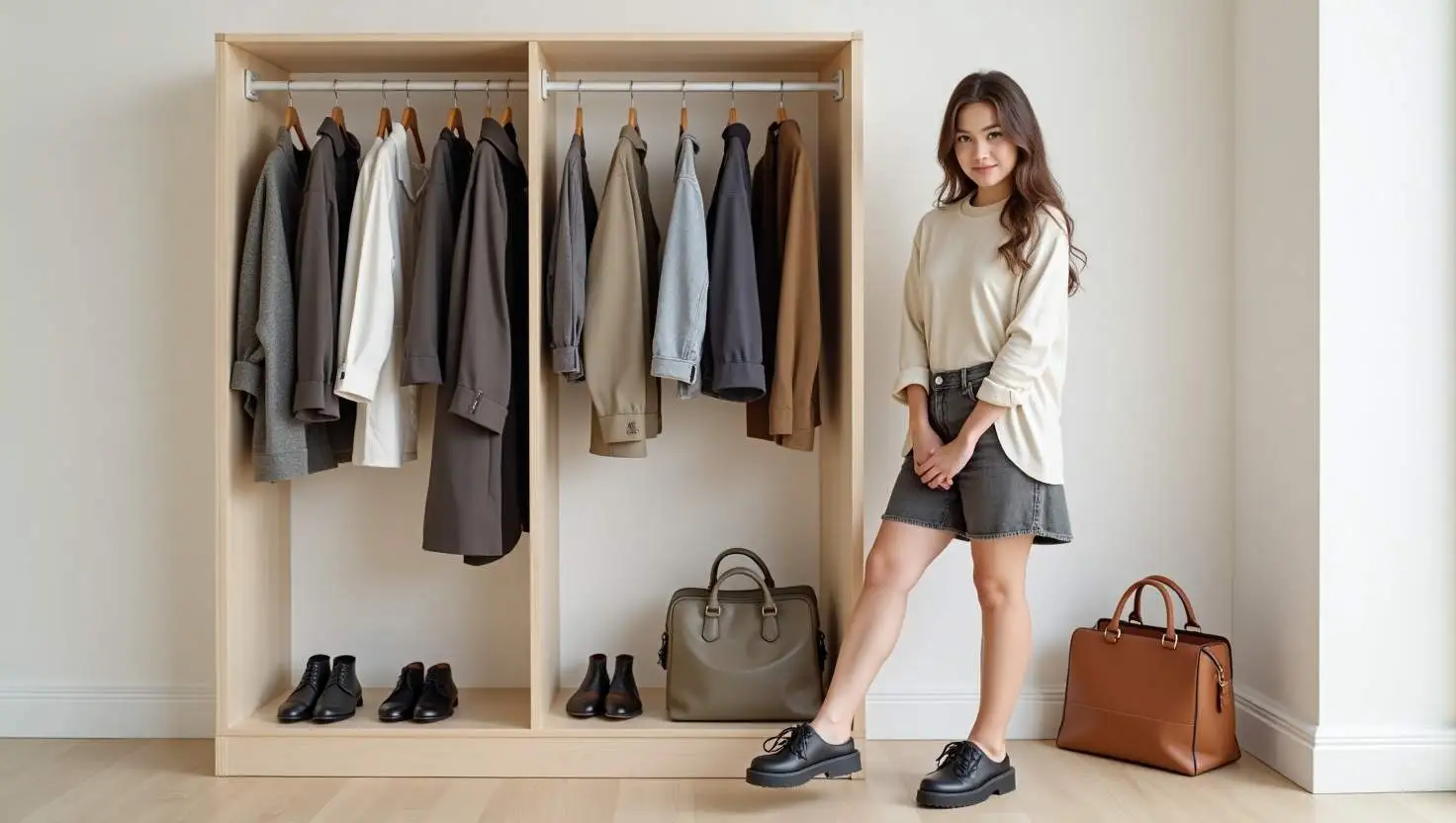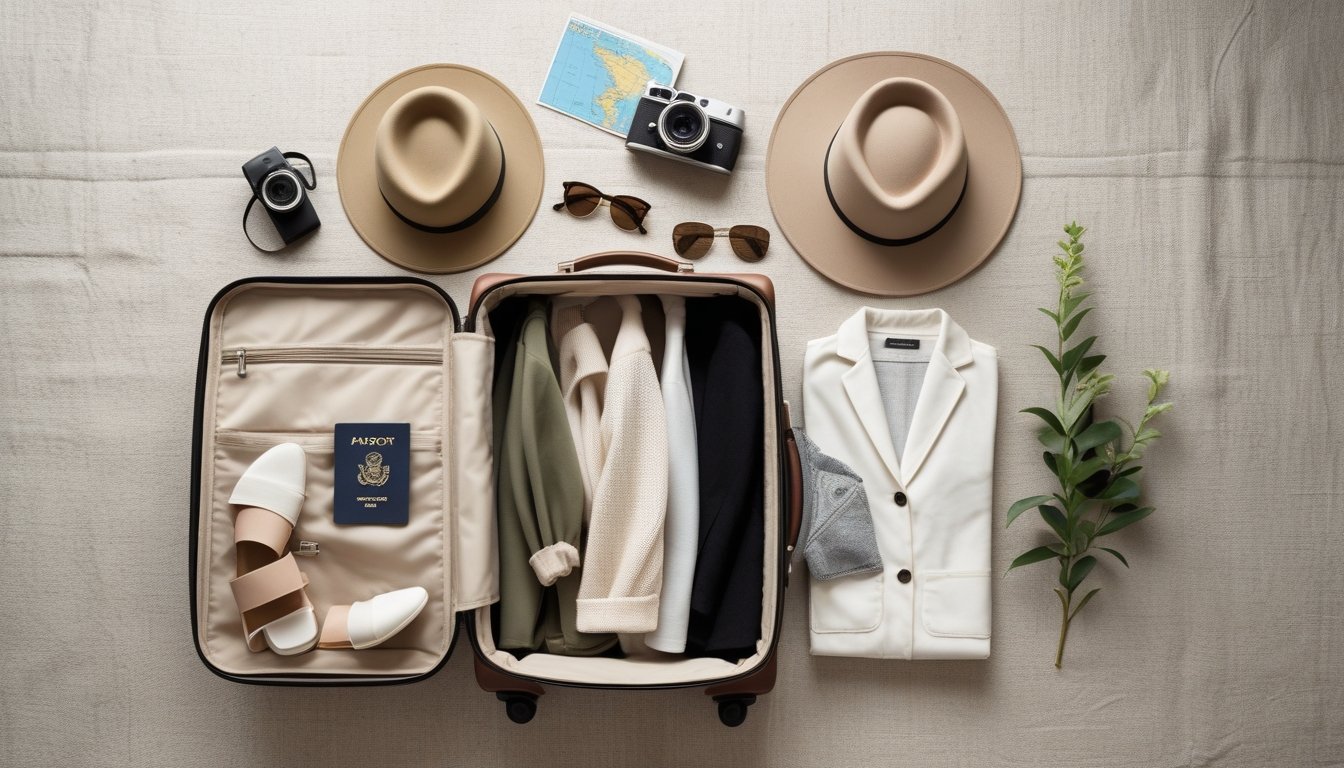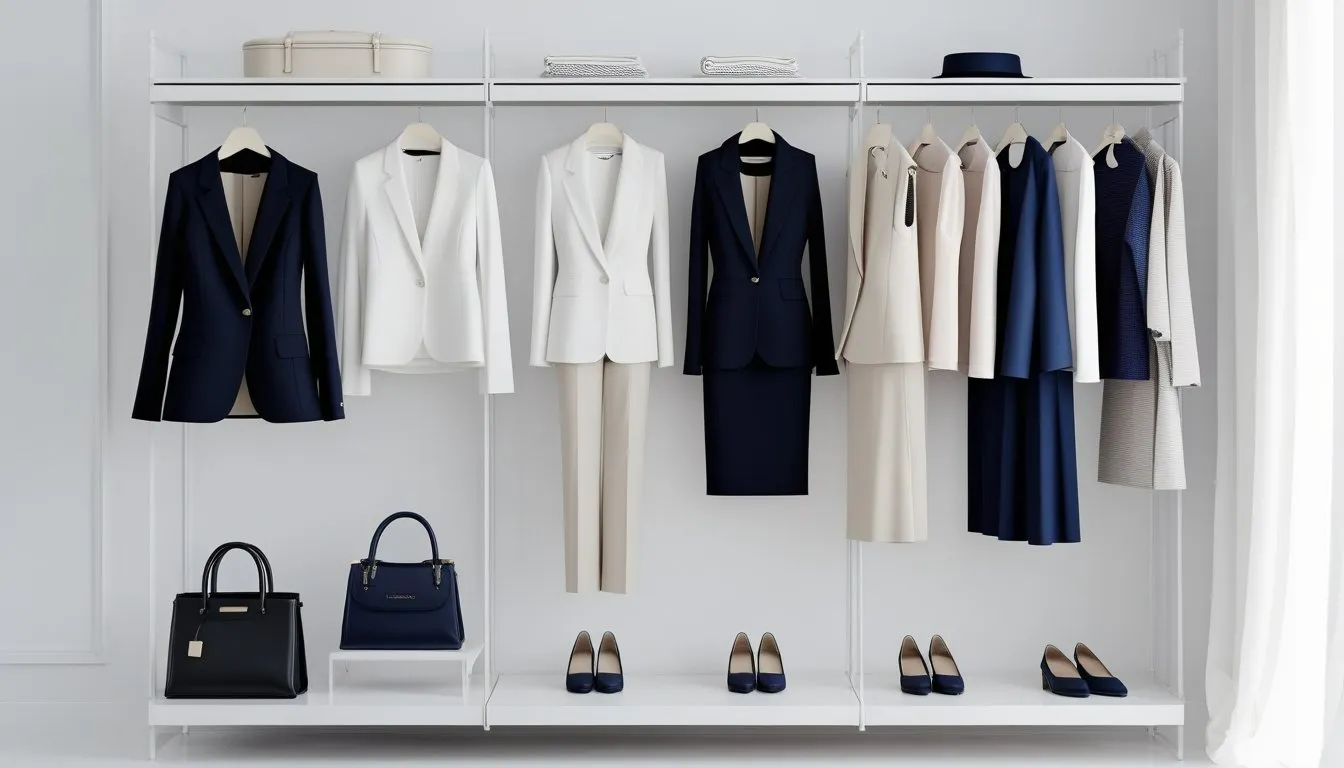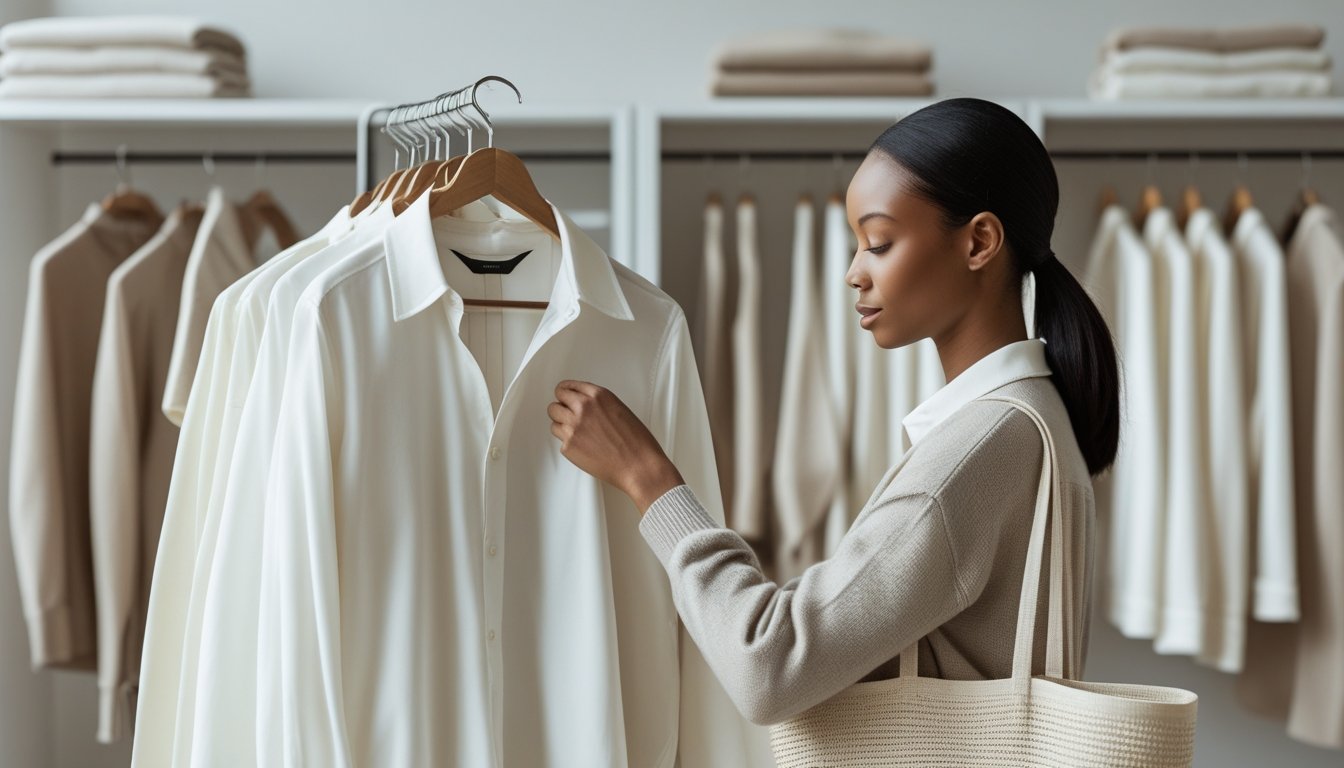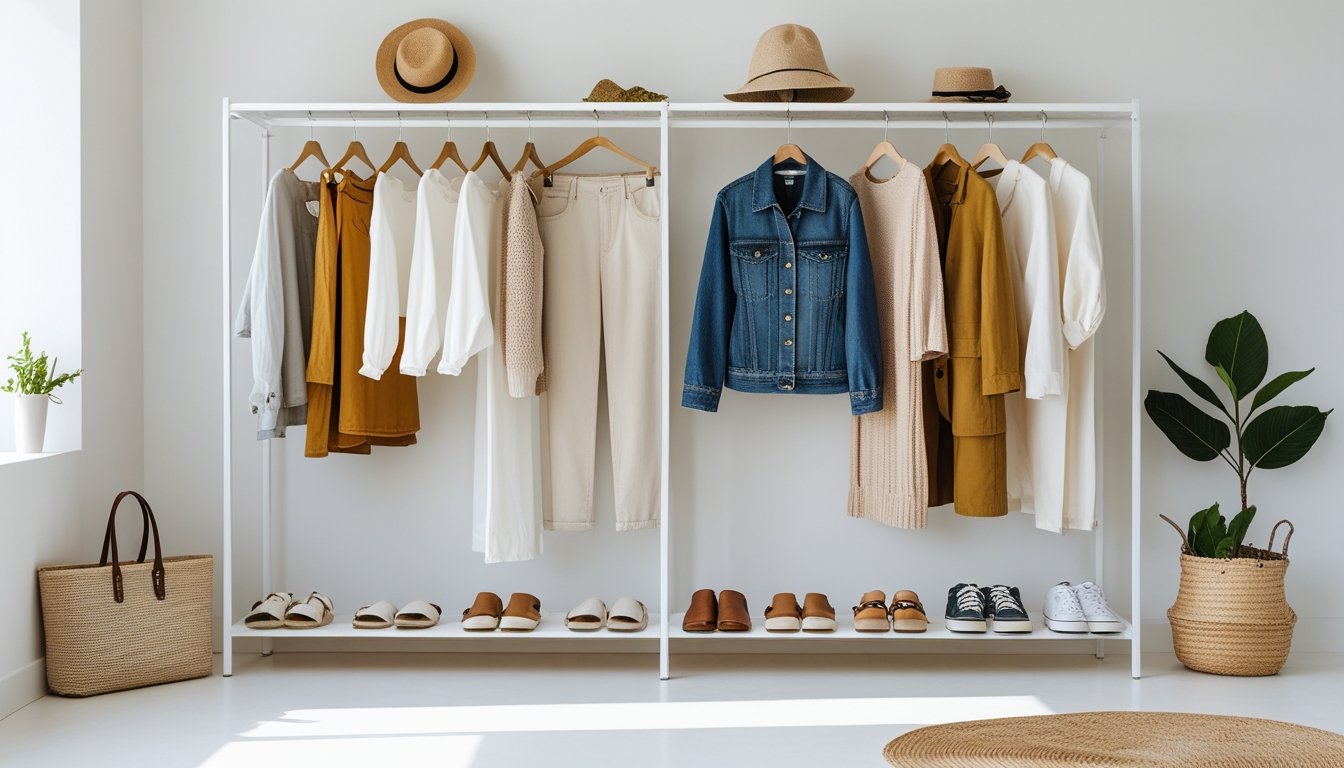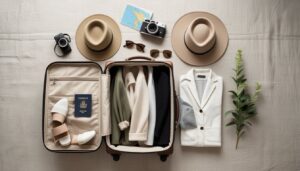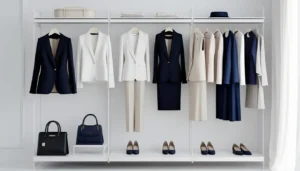What a “Minimalist Wardrobe” Really Means
A minimalist wardrobe for teenage girls in the USA is not a dull collection of identical T‑shirts. It’s a carefully chosen set of clothes that covers every typical day—classes, sports practice, family dinners, mall trips—without wasting time, money, or closet space. By trimming excess, you gain freedom: freedom from last‑minute outfit panic, freedom from peer‑pressure spending, and freedom to invest in experiences you truly value.
Why it matters:
- Less Stress Before School – When every piece mixes and matches, picking an outfit takes seconds.
- More Confidence – Owning items you genuinely love means you’ll step out the door feeling like the best version of yourself.
- Budget Control – Swapping ten fast‑fashion hauls for three quality buys saves serious allowance money.
- Planet‑Friendly – Fewer impulse purchases keep textiles out of landfills, supporting sustainable style.
Let’s discuss:
- The benefits a teen gains by going minimal
- A practical, step‑by‑step decluttering plan that won’t overwhelm you
- A shopping strategy that balances trends and timeless staples
How to personalize a lean closet so it still shouts to you. By the end, you’ll see how a curated closet can be empowering rather than restrictive. Think of it as building your own private boutique: every hanger holds a reliable friend, every drawer a guarantee of comfort—and yes, there’s still plenty of room for fun pops of color or sparkle when game day or prom night calls. Ready to start editing your style story? Let’s get started and change our wardrobe into a minimalist toolkit that works best whole year.
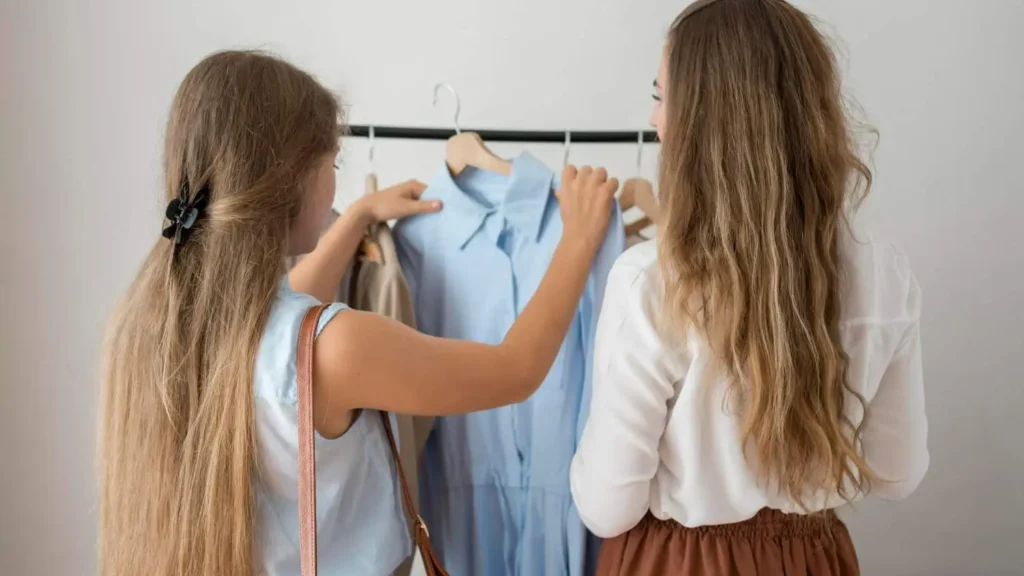
Why Teenage Girls Should Consider a Minimalist Wardrobe
High-school hallways amplify fashion pressure: trending sound bites on TikTok, weekly “new arrivals” notifications, and friends flaunting the latest drop. Yet, embracing a minimalist wardrobe as a teenage girl flips the narrative from “keep up” to “set the pace.”
Tangible Benefits
- Financial Empowerment: Stretch a small allowance by investing in versatile, durable pieces. One premium denim jacket can last through sophomore to senior year, unlike four cheaply made copies that rip at the elbows.
- Time Management: Morning routines shrink when you know every piece works together. Those reclaimed minutes can fuel a nutritious breakfast or a head start on algebra homework.
- Eco‑Consciousness: Fast‑fashion giants churn out 52 micro‑seasons a year. Refusing the cycle means fewer resources wasted and fewer garments burned or buried. That’s climate leadership before you can even vote!
- Self‑Discovery: Stripping choices down to favorites forces you to ask: What colors lift my mood? What silhouettes make me stand tall? You learn style intuition early, setting you apart in college and beyond.
Takeaway: Choosing minimalism as a teen is about confidence and clarity. You replace noisy trends with a wardrobe that champions your goals—academic, athletic, creative—while silently teaching lifelong lessons in budgeting, sustainability, and authentic self‑expression.
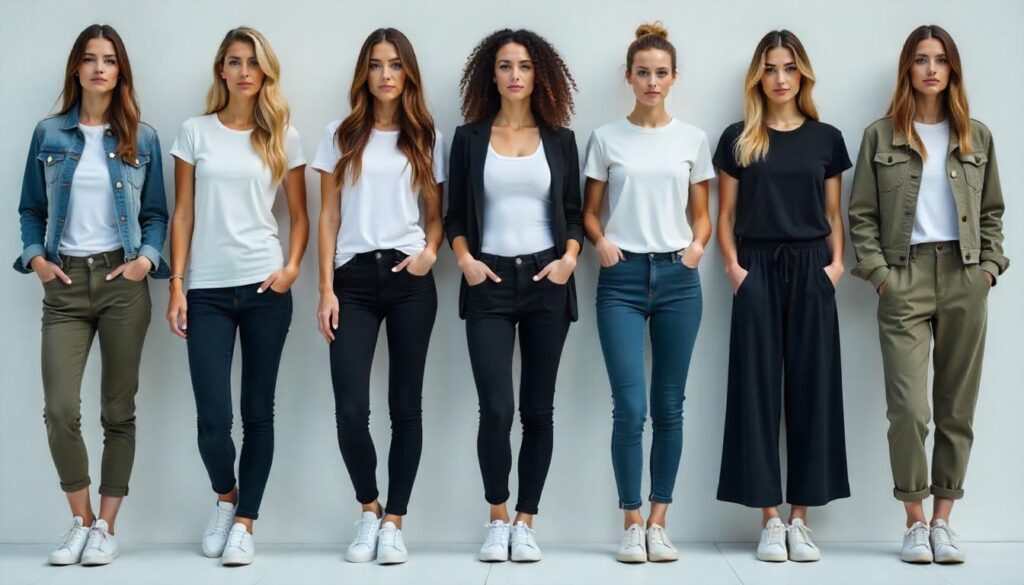
The Basics of a Minimalist Wardrobe
A solid minimalist closet rests on three pillars: versatility, cohesion, and quality. Let’s break those down.
- Versatility – Each piece should work in at least three outfits and two seasons. In August nights, a rib-knit cardigan is worn over a sundress, while in January, it is worn beneath a parka.
- Cohesion – Pick a color palette that feels “so you.” Neutrals (white, black, gray, denim blue) form an easy base. Then add two personality colors—maybe dusty rose and olive green. Limiting hues ensures near‑automatic matching.
- Quality – You don’t need designer price tags, just sturdy construction: double‑stitched hems, smooth zippers, and breathable fabrics like cotton, modal, or wool blends.
Recommended Piece Counts (Flexible Guide)
- Tops (8): Four basic tees, two long sleeves, one casual blouse, one sweatshirt.
- Bottoms (5): Two jeans (light and dark), black leggings, khaki chinos, an A‑line skirt.
- One‑Pieces (2): Everyday jumpsuit or romper, day‑to‑night T‑shirt dress.
- Outer Layers (3): Denim jacket, hoodie, lightweight puffer or trench.
- Shoes (3): White sneakers, ankle boots or dressy flats, sport sandals.
Fit & Comfort Test
Before buying, do the “classroom day” check: can you sit cross‑legged, raise your hand, climb bleachers, and sprint for the bus without adjusting? If yes, the item earns closet space.
Mindset Shift
Stop chasing “more.” Start chasing “use.” View each new piece as a teammate solving daily outfit puzzles. When everything cooperates, style stress evaporates, leaving you free to focus on GPA goals, soccer tryouts, or your budding YouTube channel.
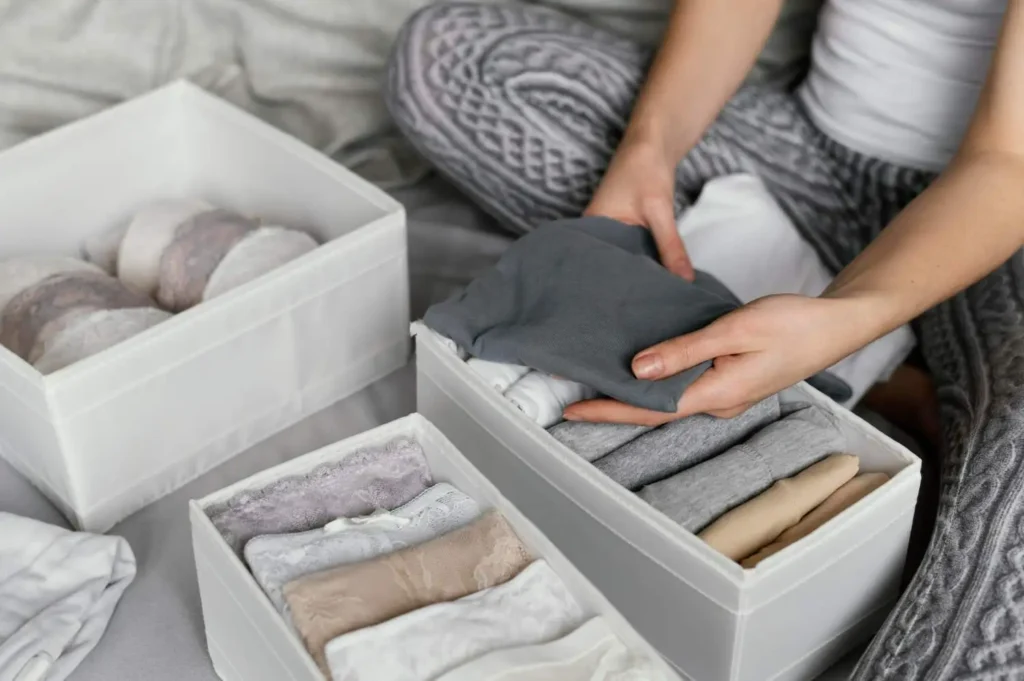
Step‑by‑Step Guide to Starting a Minimalist Wardrobe
Step 1 – Full Closet Audit
Pull every item out. Yes, every sock. Seeing the sheer volume is eye‑opening. Create three piles on the floor: Love, Maybe, Nope.
Step 2 – The “Love” Criteria
Ask these questions: Do I feel comfortable? Does it reflect my style? This season, is it possible for me to wear it at least once? If you can’t say yes, it drops to Maybe or Nope.
Step 3 – Try‑On Marathon
Put on each Maybe piece. Snap a quick mirror photo. Sometimes a photo exposes odd fits you missed. Anything that irritates you should be moved to the clutter.
Step 4 – Responsibly Release
- Donate gently used clothes to local shelters or school clothing drives.
- Sell brand‑name items on Depop, Poshmark, or Facebook Marketplace.
Step 5 – Gap List & Wishlist
After purging, jot down true gaps: perhaps you now lack a rain‑ready jacket. Rank needs by urgency to avoid impulse buying.
Step 6 – Rebuild Slowly
Limit yourself to one new item every two weeks. This cooling‑off period prevents regret. Use the “rule of three”: a piece must pair with three existing items.
Step 7 – Smart Storage
- Uniform Hangers: Thin velvet hangers save space.
- File‑Fold T‑shirts in drawers; you’ll see colors at a glance.
- Seasonal Box: Store off‑season items under the bed so your closet stays airy.
Monthly Maintenance
Schedule a 15‑minute check‑in on the first Saturday of each month. Clear any clutter creep before it snowballs. Remember, minimalism is a regular practice, not a one‑time thing to do.
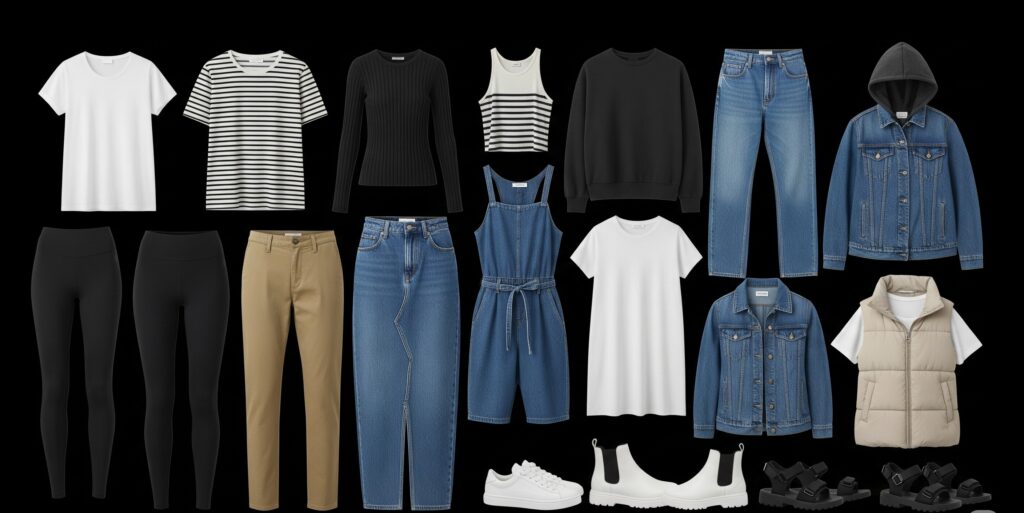
Must‑Have Clothing Pieces for a Teen Minimalist Wardrobe
Core Tops
- Classic White Tee – Layers under literally anything.
- Striped Breton Tee – Adds interest without loud graphics.
- Black Rib‑Knit Long Sleeve – Works solo or under slip dresses.
- You will look stylish and be comfortable in a Crewneck Sweatshirt in Accent Color
Essential Bottoms
- Medium‑Wash Straight‑Leg Jeans: Dress them up with flats or down with sneakers.
- Jet‑Black Leggings: PE class to weekend errands.
- ** Khaki or Olive Chinos:** School presentations or job interviews.
- In winter Denim skirt with tights and in summer bare legs.
One‑Piece Wonders
- Soft T‑Shirt Dress: Throw on and go; belt it for shape or layer over leggings.
- Jumpsuit/Romper: Instant outfit; pick a solid neutral to maximize styling options.
Layering Heroes
- Mid‑Weight Denim Jacket: Timeless American staple that just gets better with wear.
- Bonded Hoodie: Cozy for bus rides and late‑night cram sessions.
- Lightweight Puffer Vest or Trench: Region‑dependent outer shell for shoulder seasons.
Footwear Trio
- White Low‑Top Sneakers – Gym class clearance plus street style.
- Chelsea Boots or Ballet Flats – Dressier option for concerts, debate meets.
- Sport Sandals or Slides – Quick errands, pool days, locker‑room ease.
Climate Adaptations
- Northern Winters: Add thermal leggings and waterproof boots.
- Southern Summers: Swap heavy jeans for breathable linen shorts.
Having these thoughtfully selected pieces means outfits practically assemble themselves; you’ll stay photo‑ready while traveling light—physically and mentally.
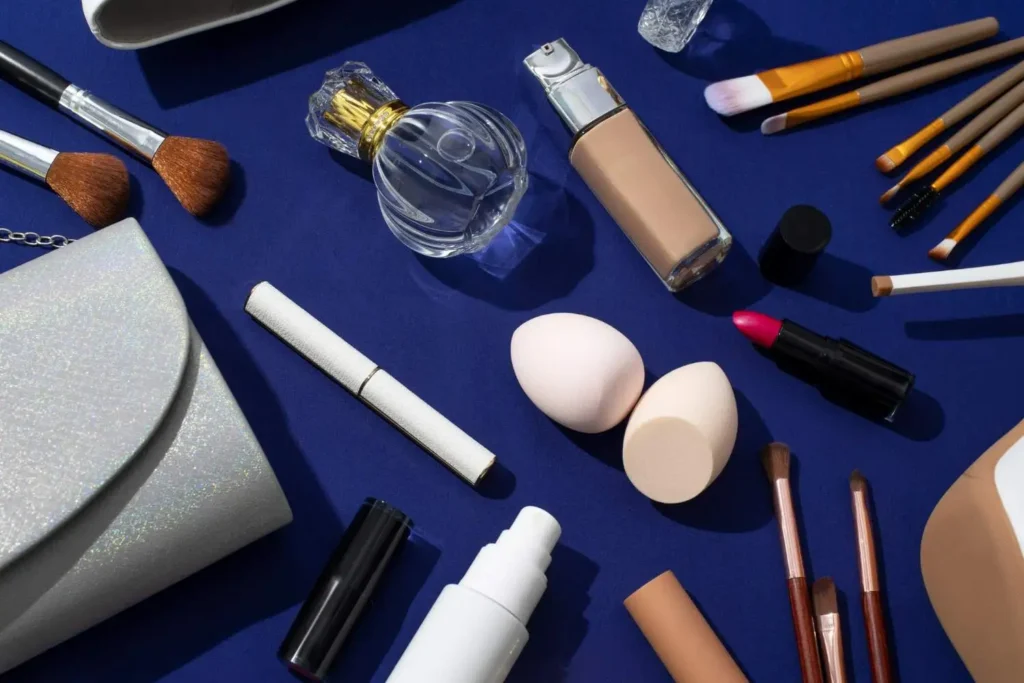
Accessories & Extras: Keeping Balance
Accessories in a minimalist wardrobe are the spice rack—small but flavor‑packed. A clear plan protects you from turning “minimal” into “maximal” overnight.
Jewelry Capsule
- Daily Studs or Hoops – Pick hypoallergenic metal so you can sleep in them.
- Dainty Pendant Necklace – Sits well above most necklines.
- Statement Ring or Cuff – Instantly elevates neutral outfits on special occasions.
Bags
- Structured Backpack – Fits books and a laptop while looking polished.
- Cross‑Body Bag – Weekend outings, concerts, or mall hangs.
Belts & Hats
- Classic Belt: Reversible black/brown doubles its use.
- Seasonal Hat: Beanie for chill states; bucket hat for sunny regions.
Hair & Tech Extras
Keep accessories in a labeled tray:
- 6 color‑coordinated scrunchies
- 2 claw clips
- 1 slim headband
- Phone case that complements your palette (little things matter!)
The 30‑Day Rule
If an accessory goes untouched for a month, store it out of sight. If you don’t miss it after another 30 days, release it.
Storage Tips
Use a pegboard or cork strip inside the closet door for necklaces and belts—visual organization prevents over‑buying duplicates.
Remember, minimalist styling is about intentional highlights. Instead of piling on trends, let a single playful scarf or bold pair of socks become your signature. That controlled flash feels far more “you” than an avalanche of mismatched pieces—and it keeps drawers blissfully uncluttered.

Shopping Smart as a Teenager
Set an Annual Clothing Budget
Figure out what you realistically spend each year. Divide by 12 for a monthly cap—say $40. Track every purchase in a free notes app or Google Sheet.
Implement the 48‑Hour Cart Strategy
- Add to Cart – Just select the color and size, and add to cart
- Wait 48 Hours – Time weakens the impulse.
- Reevaluate – Still excited? Purchase. Forgotten? Delete.
Hunt Quality on a Budget
- Thrift Stores: Visit upscale neighborhoods for higher‑end cast‑offs.
- Online Thrifting: Poshmark “like new” filters narrow options fast.
- Outlet Malls: Go with a strict shopping list and leave when it’s crossed off.
- Seasonal Sales: Buy winter coats in March, sandals in September.
Red Flags to Avoid
- Ultra‑Low Prices: If a tee costs less than lunch, question material ethics.
- One‑Wear Wonders: Trendy prints that scream one specific event.
- Duplicate Purchases: Multiple black hoodies? Choose the best, skip the rest.
Quality Checklist for Teens
- Tug seams gently—no gap means durable construction.
- Hold fabric up to light—minimal sheerness equals longer life.
- Check tags—natural fibers breathe and resist odors.
Swap & Borrow Economy
Host clothing swaps each semester with friends. Agree on hygiene rules (freshly laundered) and trade tokens (one token per item) to keep fairness. Borrow special‑occasion dresses instead of buying; reciprocate with your own pieces.
Strategic shopping transforms you from passive consumer to savvy style curator, ensuring every dollar—and every hanger—works hard.
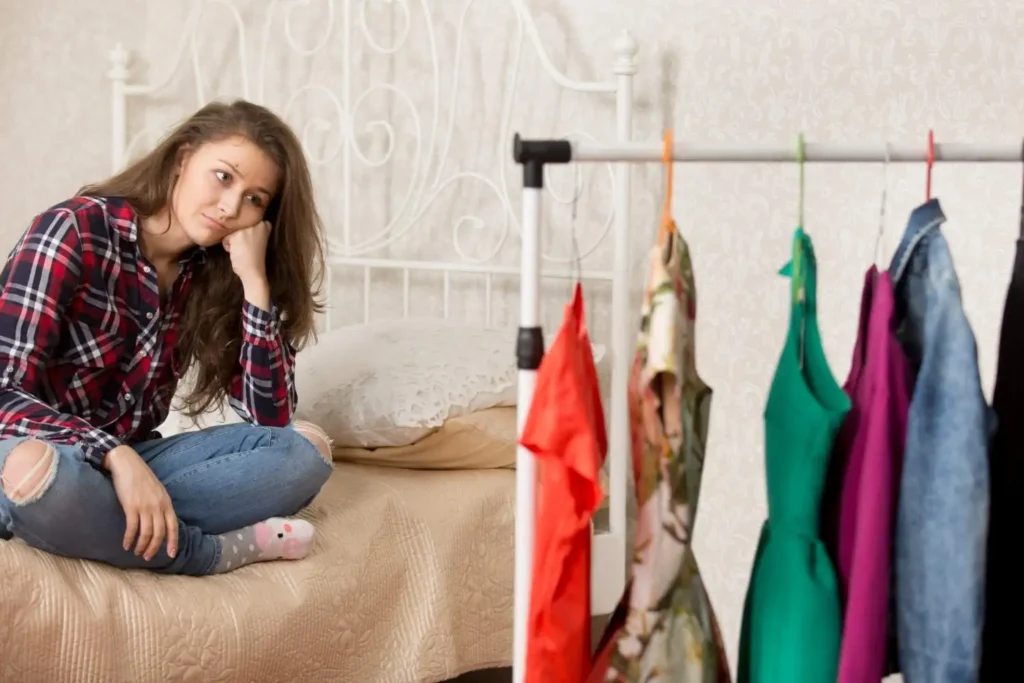
How to Personalize Your Minimalist Style
Minimalism isn’t a synonym for monotony. Within a streamlined closet lies infinite room for creativity—just applied with intention.
Color Pop Strategy
Stick to your neutral palette for most garments, then sprinkle in accents: maybe a sunflower‑yellow bucket hat or turquoise shoelaces. These micro‑pops draw the eye without breaking cohesion.
Texture Play
- Pair ribbed cotton with sleek satin for casual‑glam contrast.
- Mix chunky knits over flowy rayon skirts when seasons shift.
- Use faux‑leather trims or embroidered patches to add a subtle edge.
Statement‑Piece Rule
Limit outfits to one statement item—like printed wide‑leg pants or glitter sneakers—so the look stays balanced and authentically minimalist.
DIY Customizations
- Swap plain buttons for vintage‑inspired wood or pearl versions.
- Add iron‑on patches representing your hobbies (skateboarding, coding, K‑pop fandom).
- Crop old tees into boxy silhouettes; hem raw edges for a polished finish.
Inspiration Sources
- Pinterest Boards: Search “teen minimalist outfits,” save pins that resonate.
- Instagram Hashtags: #MinimalistTeenStyle, #CapsuleWardrobeYouth.
- Real Life: Observe hallways; note color combos that pop but still look cohesive.
Confidence Loop
Personal touches make you feel seen. Feeling seen boosts confidence. Confidence encourages more authentic styling. Soon, you’re the trendsetter others copy—and you did it without buying the entire mall.
Remember: minimalism is the canvas, you are the artist. Paint purposefully, and every hallway strut becomes a mini runway walk of self‑expression.
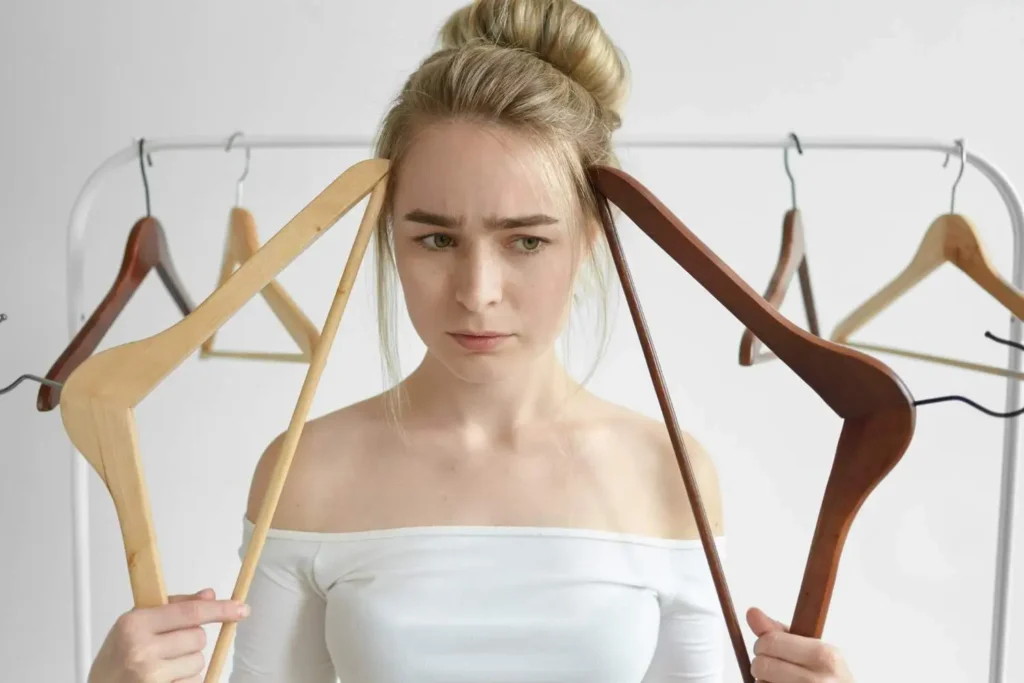
Common Mistakes to Avoid
1. Purging Everything Overnight
A weekend‑long “all or nothing” toss often backfires, leading to buyers’ remorse Monday morning. Gradual edits let you observe what you truly miss.
2. Following Rigid Capsule Numbers
Thirty‑three items may work for that influencer, but you might need forty‑five due to sports uniforms or the climate. Use counts as guides, not commandments.
3. Buying “Basics” You Dislike
If you hate button‑up shirts, skip them—even if every minimalist list says otherwise. Your closet serves you, not blog checklists.
4. Trading Variety for Boredom
Minimalism encourages cohesion, but if everything is gray, you may feel color‑starved. Schedule micro‑experiments—like adding lavender socks—to keep excitement alive.
5. Chasing Every “Timeless” Trend
Marketing rebrands trends as “new classics”—think shackets or balloon jeans. Pause before labeling anything timeless; let styles simmer a season.
6. Ignoring Lifestyle Changes
Transitioning from high school to college? Climate, social events, and dress codes shift. Review wardrobes every semester to ensure alignment with daily life.
7. Guilt Over Gifts
Unwanted gifted sweaters clog space. Politely thank the giver, then donate or resell. Guilt doesn’t earn closet real estate.
8. Equating Cost with Quality
High price tags can conceal poor stitching. Apply the quality checklist—fabric weight, seams, hardware—before investing.
Avoiding these pitfalls keeps teen minimalist wardrobes practical, happy, and sustainable, rather than restrictive or anxiety‑inducing.
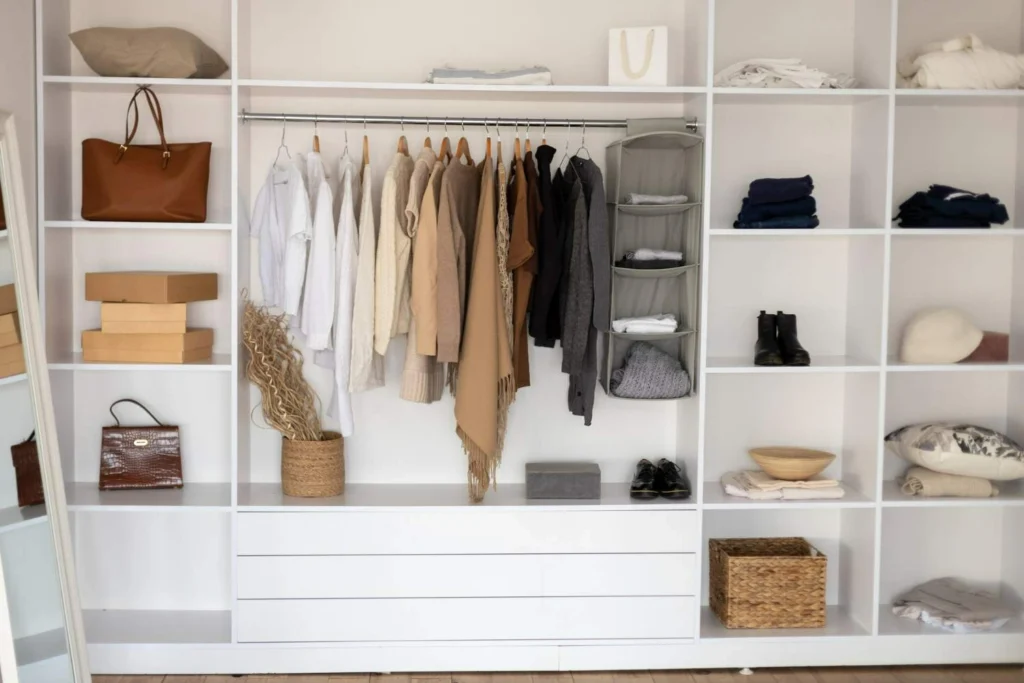
Final Thoughts & Motivation to Get Started
Think of minimalism as curating your highlight reel. Each garment narrates something positive: comfort, confidence, creativity. When your closet holds only highlights, mornings transform from chaotic roulette to empowering routine.
Quick‑Start Challenge
Tonight, pick just five items you know you’ll never wear again. Bag them for donation. That tiny step sparks momentum—tomorrow, you might let go of ten more.
Celebrate Micro‑Wins
- First Empty Hanger: Proof you’re making space for life, not clutter.
- First Intentional Purchase: The thrill of buying because it serves you, not because it was on sale.
- First Compliment: When a friend says, “You always look put together,” that’s confirmation that your curated closet shines.
Long‑Term Payoffs
- Financial Freedom: Redirect saved dollars to driving lessons, SAT prep, or that dream summer road trip.
- Environmental Impact: Each fewer T‑shirt produced saves roughly 700 gallons of water—multiply that across a lifetime.
- Self‑Discovery: Clothing becomes a mirror of internal growth rather than external noise.
Parting Encouragement
Minimalism is not the absence of style—it’s the intentional presence of your style. Start small, stay patient, and treat edits as acts of self‑respect. Six months from now you’ll open a closet that feels like a hand‑picked Pinterest board—only every pin belongs to you in real life. That’s the power of a teenage minimalist wardrobe: less distraction, more you. Now go claim your space.

